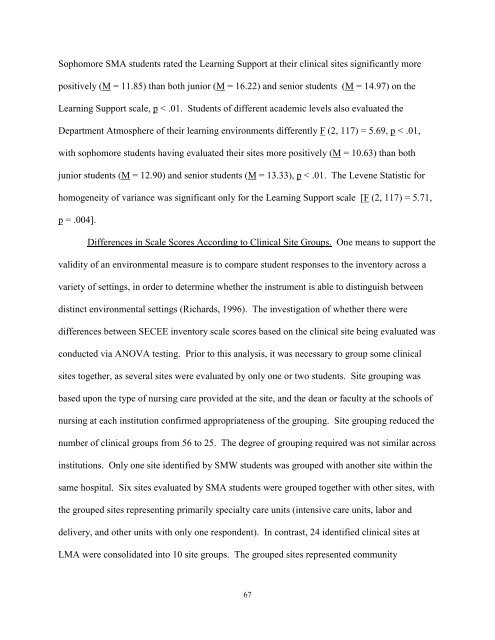STUDENT EVALUATION OF CLINICAL EDUCATION ENVIRONMENT
STUDENT EVALUATION OF CLINICAL EDUCATION ENVIRONMENT
STUDENT EVALUATION OF CLINICAL EDUCATION ENVIRONMENT
Create successful ePaper yourself
Turn your PDF publications into a flip-book with our unique Google optimized e-Paper software.
Sophomore SMA students rated the Learning Support at their clinical sites significantly more<br />
positively (M = 11.85) than both junior (M = 16.22) and senior students (M = 14.97) on the<br />
Learning Support scale, p < .01. Students of different academic levels also evaluated the<br />
Department Atmosphere of their learning environments differently F (2, 117) = 5.69, p < .01,<br />
with sophomore students having evaluated their sites more positively (M = 10.63) than both<br />
junior students (M = 12.90) and senior students (M = 13.33), p < .01. The Levene Statistic for<br />
homogeneity of variance was significant only for the Learning Support scale [F (2, 117) = 5.71,<br />
p = .004].<br />
Differences in Scale Scores According to Clinical Site Groups. One means to support the<br />
validity of an environmental measure is to compare student responses to the inventory across a<br />
variety of settings, in order to determine whether the instrument is able to distinguish between<br />
distinct environmental settings (Richards, 1996). The investigation of whether there were<br />
differences between SECEE inventory scale scores based on the clinical site being evaluated was<br />
conducted via ANOVA testing. Prior to this analysis, it was necessary to group some clinical<br />
sites together, as several sites were evaluated by only one or two students. Site grouping was<br />
based upon the type of nursing care provided at the site, and the dean or faculty at the schools of<br />
nursing at each institution confirmed appropriateness of the grouping. Site grouping reduced the<br />
number of clinical groups from 56 to 25. The degree of grouping required was not similar across<br />
institutions. Only one site identified by SMW students was grouped with another site within the<br />
same hospital. Six sites evaluated by SMA students were grouped together with other sites, with<br />
the grouped sites representing primarily specialty care units (intensive care units, labor and<br />
delivery, and other units with only one respondent). In contrast, 24 identified clinical sites at<br />
LMA were consolidated into 10 site groups. The grouped sites represented community<br />
67












